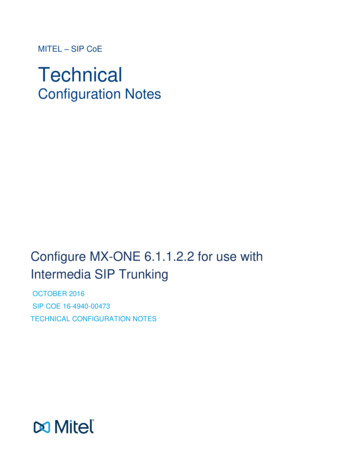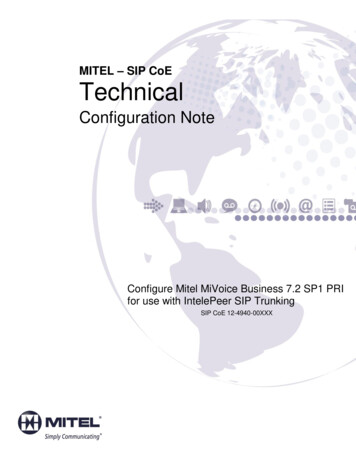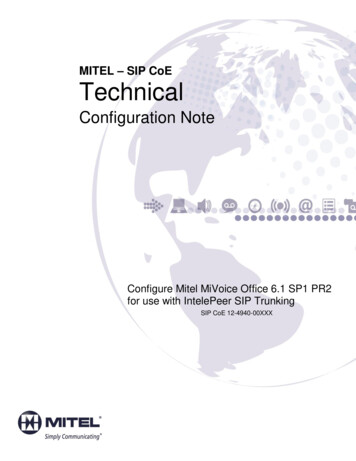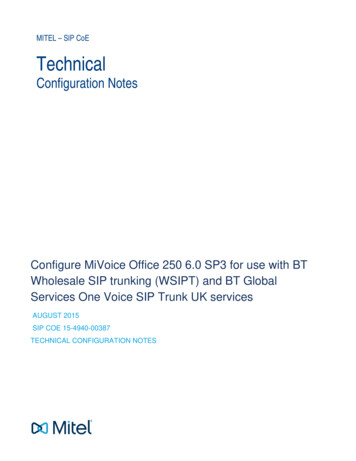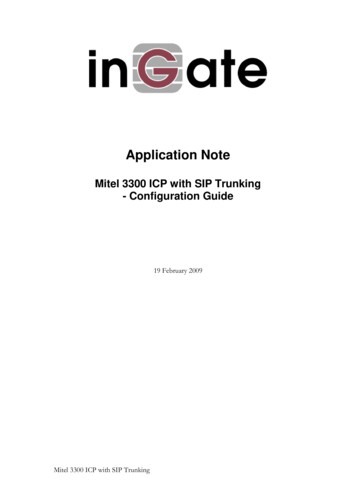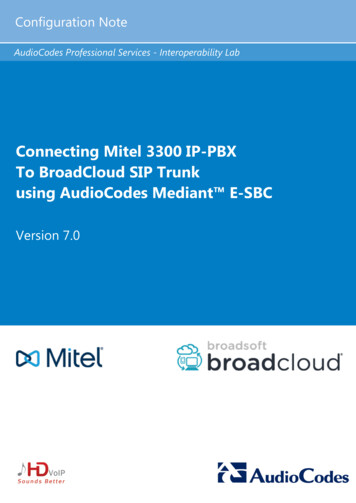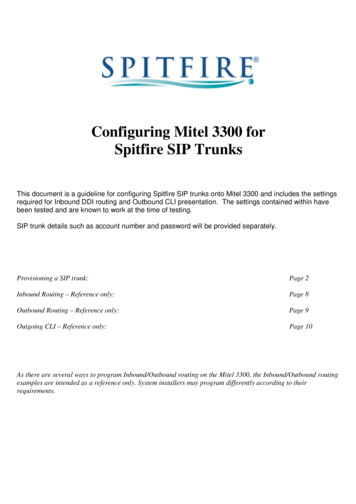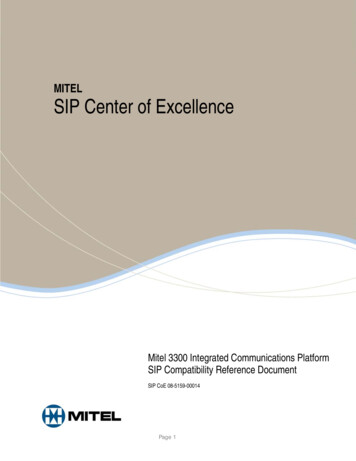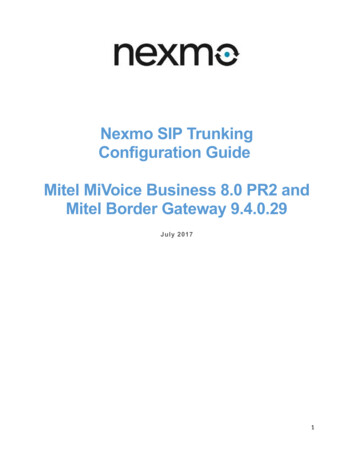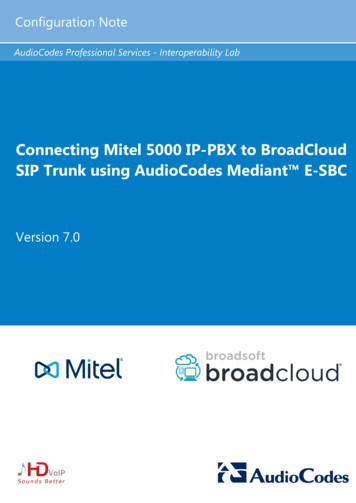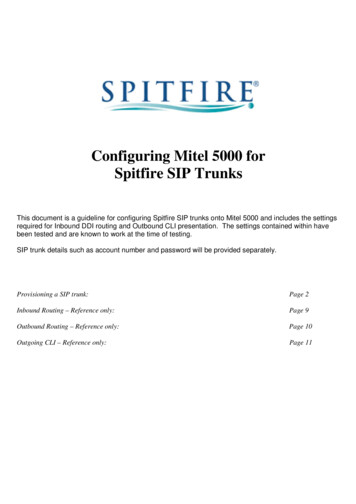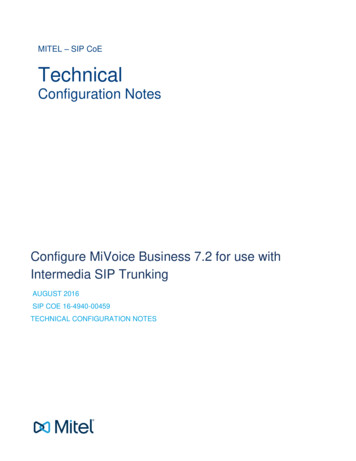
Transcription
MITEL – SIP CoETechnicalConfiguration NotesConfigure MiVoice Business 7.2 for use withIntermedia SIP TrunkingAUGUST 2016SIP COE 16-4940-00459TECHNICAL CONFIGURATION NOTES
NOTICEThe information contained in this document is believed to be accurate in all respects butis not warranted by Mitel Networks Corporation (MITEL ). The information is subjectto change without notice and should not be construed in any way as a commitment byMitel or any of its affiliates or subsidiaries. Mitel and its affiliates and subsidiariesassume no responsibility for any errors or omissions in this document. Revisions of thisdocument or new editions of it may be issued to incorporate such changes.No part of this document can be reproduced or transmitted in any form or by any means electronic or mechanical - for any purpose without written permission from Mitel NetworksCorporation.TRADEMARKSMitel is a trademark of Mitel Networks Corporation.Windows and Microsoft are trademarks of Microsoft Corporation.Other product names mentioned in this document may be trademarks of their respectivecompanies and are hereby acknowledged.Mitel Technical Configuration Notes:Configure MiVoice Business 7.2 for use with Intermedia SIP TrunkingAugust 2016 – 16-4940-00459 , Trademark of Mitel Networks Corporation Copyright 2016, Mitel Networks CorporationAll rights reservedii
Table of ContentsOVERVIEW . 1Interop History. 1Interop Status . 1Software & Hardware Setup . 2Tested Features . 2Device Limitations and Known Issues . 3Network Topology . 4CONFIGURATION NOTES . 5MiVoice Business Configuration Notes . 6Network Requirements . 6Assumptions for MiVoice Business Programming . 6Licensing and Option Selection – SIP Licensing . 7Class of Service Options . 8Network Elements . 10Network Elements (Proxy). 11Trunk Attributes . 12SIP Peer Profile . 13SIP Peer Profile Assignment by Incoming DID . 19ARS Digital Modification Plans . 20ARS Routes . 21ARS Digits Dialed . 22Fax Configuration . 23Network Zones . 24MITEL BORDER GATEWAY SETUP . 25MiVoice Business Setup . 25SIP Trunk Setup. 26iii
16-4940-00459Intermedia SIP Trunking with MiVoice BusinessOverviewThis document provides a reference to Mitel Authorized Solutions providers for configuringthe MiVoice Business (MiVB) 7.2 to connect to the Intermedia SIP trunk. Differentcomponents can be configured in various configurations depending on your VoIP solution.This document covers a basic setup with required option setup.Interop HistoryVersionDateReason1October, 2008Initial Interop with Mitel 3300 9.0 and Accessline SIP ServiceProvider v12.1.02September, 2009Refresh Interop with Mitel 3300 MCD 4.0 and Accessline SIPService Provider v14.4.53April 1, 2011Refresh Interop with Mitel MCD 4.2 SP1 and Accessline v15.2.04July 14, 2016Recertification Interop with MiVoice Business (MiVB) 7.2 andIntermedia v16.14.35Aug 17, 2016Updated notes - Recertification Interop with MiVoice Business(MiVB) 7.2 and Intermedia v16.14.3Interop StatusThis Interop of Intermedia with MiVoice Business 7.2 has been given a CompatibleCertification status. This SIP trunk will be included in the SIP CoE Reference Guide.The most common certification which means MiVoice Business hasbeen tested and/or validated by the Mitel SIP CoE team. Productsupport will provide all necessary support related to the interop, butissues unique or specific to the 3rd party will be referred to the 3rd partyas appropriate.1
16-4940-00459Intermedia SIP Trunking with MiVoice BusinessSoftware & Hardware SetupThe table below provides the hardware and software specifications used to generate basiccalls, using Intermedia SIP trunk connected to MiVoice Business 7.2.ManufacturerVariantSoftware VersionIntermediaSession Border Controller16.14.3MitelMiVoice Business 7.2 – Mxe PlatformRel: 7.2, Active SW: 13.2.0.17MitelMBG SIP Trunk & TeleworkerMSL: 10.3.33.0, MBG: 9.1.1.41MitelNuPoint Unified MessengerMitelAudio, Web and Video ConferencingAastra68xxi SIP set4.1.0.128 or 4.2.0.181Mitel53xx Sets06.03.01.03 (MiNET)17.0.0.24.015.0.3.33-1Tested FeaturesBelow table provides an overview of the features tested during the Interoperability test cycleand not a detailed view of the test cases. Please see the SIP Trunk Side Interoperability TestPlan for detailed test cases.FeatureIssuesBasic CallMaking and receiving a call through SIP service providerand their PSTN gateway, call holding, transferring,conferencing, busy calls, long calls durations, variablecodec.Automatic CallDistributionMaking calls to an ACD environment with RAD treatments,Interflow and Overflow call scenarios and DTMF detection.NuPoint VoicemailTerminating calls to a NuPoint voicemail boxes and DTMFdetection.PacketizationForcing the Mitel MIVB to stream RTP packets through itsE2T card at different intervals, from 10ms to 60ms.Personal RingGroups (PRG)Receiving calls through MiVoice Business and their PSTNgateway to a personal ring group. Also moving callsto/from the prime member and group members.TeleworkerMaking and receiving a call through MiVoice Business andtheir PSTN gateway to and from Teleworker extensions.VideoMaking and receiving a call through MiVoice Business withvideo capable devices.FaxG.711 Fax calls.- No issues found2Feature Description- Issues found, cannot recommend to use- Issues foundNot tested/applicable
16-4940-00459Intermedia SIP Trunking with MiVoice BusinessDevice Limitations and Known IssuesThis is a list of problems or not supported features when Intermedia SIP trunk is connected tothe. MiVoice Business 7.2FeatureFAXProblem DescriptionIntermedia does not support FAX using T.38.Recommendation: Consult with Intermedia for further information andupdates.PRACKIntermedia does not support PRACK correctly in the following callscenario,- A call from Mitel to PSTN service such as conferencing or IVR system- The PSTN sends alerting 183 and immediately connecting the call with200 OKRecommendation: Mitel recommends to disable PRACK when SIPTrunking with Intermedia as already noted in this configuration guide.Consult with Intermedia for further information and updates.VideoIntermedia does not support Video.Recommendation: Consult with Intermedia for further information andupdates.3
16-4940-00459Intermedia SIP Trunking with MiVoice BusinessNetwork TopologyThis diagram shows how the testing network is configured for reference.Mitel SIP InteroperabilityNetwork ConfigurationAastra 6867iSIP PhoneAastra 6867iSIP oice Business(MiVB)Figure 1 – Network Topology4Intermedia SBC
16-4940-00459Intermedia SIP Trunking with MiVoice BusinessConfiguration NotesThis section is a description of how the SIP Interop network was configured. These notesprovide a guideline as how a device can be configured in a customer environment and howthe Intermedia and MiVB programming were configured in our test environment.Disclaimer: Although Mitel has attempted to setup the interop testing facility as closelyas possible to a customer premise environment, implementation setup could bedifferent onsite. YOU MUST EXERCISE YOUR OWN DUE DILIGENCE IN REVIEWING,planning, implementing, and testing a customer configuration.This section provides an example of non-overlapping dial plan configuration for Intermediaand MiVB systems. In the example, MiVB and Intermedia systems use the followingextension numbers: Intermedia dial plan includes extensions 2066863771 and 2066866403. MiVoice Business dial plan includes extensions 7800 – 7899.Four-Digit Plans: When configuring, adhere to the guidelines provided in the ITURecommendation E.164 to ensure that both systems interpret and route phone numberscorrectly. The E.164 recommendation is available on the International TelecommunicationsUnion Web site at http://www.itu.int/rec/T-REC-E.164/en.5
16-4940-00459Intermedia SIP Trunking with MiVoice BusinessMiVoice Business Configuration NotesThe following information shows how to configure a MiVB 7.2 to interconnect with Intermedia.Network Requirements There must be adequate bandwidth to support the VoIP network. As a guide, theEthernet bandwidth is approx 85 Kb/s per G.711 voice session and 29 Kb/s per G.729voice session (assumes 20ms packetization). As an example, for 20 simultaneous SIPsessions, the Ethernet bandwidth consumption will be approx 1.7 Mb/s for G.711 and0.6Mb/s. Almost all Enterprise LAN networks can support this level of traffic without anyspecial engineering. Please refer to the MiVoice Business Engineering guidelines on theMitle eDocs Website (http://edocs.mitel.com) for further information. For high quality voice, the network connectivity must support a voice-quality grade ofservice (packet loss 1%, jitter 30ms, one-way delay 80ms).Assumptions for MiVoice Business Programming 6The SIP signaling connection uses UDP on Port 5060
16-4940-00459Intermedia SIP Trunking with MiVoice BusinessLicensing and Option Selection – SIP LicensingEnsure that MiVoice Business is equipped with enough SIP trunking licenses for theconnection to Intermedia. This can be verified within the License and Option Selectionform.Enter the total number of licenses in the SIP Trunk Licences field. This is the maximumnumber of SIP trunk sessions that can be configured in the MiVB to be used with all serviceproviders, applications and SIP trunking devices.Figure 2 – License and Option Selection7
16-4940-00459Intermedia SIP Trunking with MiVoice BusinessClass of Service OptionsThe Class of Service Options form is used to create or edit a Class of Service and specifythe associated options. Classes of Service, identified by Class of Service numbers, arereferenced in the Trunk Attributes form for SIP trunks.Many different options may be required for your site deployment, but ensure that PublicNetwork Access via DPNSS Class of Service Option is configured for all devices that makeoutgoing calls through the SIP trunks in the MiVoice Business. Public Network Access via DPNSS set to YesIf use FAX equipment ensure that the following options are enabled,8 Campon Tone Security/FAX Machine set to Yes Busy Override Security set to Yes
16-4940-00459Intermedia SIP Trunking with MiVoice BusinessFigure 3 – Class of Service Options9
16-4940-00459Intermedia SIP Trunking with MiVoice BusinessNetwork ElementsCreate a network element for a SIP Peer, Intermedia. In this example, the gateway isreachable by an IP Address and is defined as Intermed in the Network Elements form. TheFQDN or IP addresses of the SIP Peer (Network Element), the External SIP Proxy, andRegistrar are provided by your service provider.If your service provider trusts your network connection by asking for your gateway external IPaddress, then programming the IP address for the SIP Peer, Outbound Proxy and Registraris not required for SIP trunk integration. This will need to be verified with your serviceprovider. Please note that in our example, Intermedia has requested to set the transport toUDP and port to 6060, as oppose to default 5060.Figure 4 – Network Elements10
16-4940-00459Intermedia SIP Trunking with MiVoice BusinessNetwork Elements (Proxy)Depending on your configuration, a Proxy may need to be configured to route SIP data to theservice provider. If you have a Proxy server installed in your network, MiVoice Businessrequire knowledge of this by programming the Proxy as a network element, then referencingthis Proxy in the SIP Peer profile, as you see later in this document.Below shows configuration for MBG trunk Network Element as Outbound Proxy that is usedin this interop for correct routing.Figure 5 – Network Elements for Outbound Proxy11
16-4940-00459Intermedia SIP Trunking with MiVoice BusinessTrunk AttributesUse Trunk Attributes form to configure Trunk Service Number. In this example, the TrunkService Number 12 will be used to direct incoming calls to an answer point in MiVoiceBusiness.Program the Non-dial In or Dial In Trunks (DID) according to the site requirements and whattype of service was ordered from your service provider.Figure 6 below shows configuration for incoming DID calls. The MiVoice Business willabsorb the first 6 digits of the DID number received from Intermedia’s SIP trunk leaving 4digits for MiVoice Business to translate and ring the 4-digit extension.For example, the Intermedia’s SIP trunk delivers numbers 206-686-6403 through SIP trunk toMiVoice Business, which will absorb the first 6 digits (206686) leaving the remaining 4 digits(6403) to route the call. Number 6403 must be programmed as a valid dialable number in theMiVoice Business. Alternatively, you can create a System Speed Call number to associate6403 with the real telephone extension in MiVB. Please refer to MiVoice Business 7.2System Administration documentation for further programming information.Figure 6 – Trunk Service Assignment12
16-4940-00459Intermedia SIP Trunking with MiVoice BusinessSIP Peer ProfileThe recommended connectivity via SIP Trunking does not require additional physicalinterfaces. IP/Ethernet connectivity is part of the base MiVoice Business Platform. The SIPPeer Profile should be configured as shown in Figures 7 - 12.The settings on all other tabs of SIP Peer Profile form remain unchanged, at their defaultvalues. Click Save to submit the settings.Under Basic tabs:Network Element: The selected SIP Peer Profile needs to be associated with previouslycreated Intermed Network Element.Registration User Name: The MiVoice Business does not support Bulk registration. As suchtrunks have to be registered individually. As Intermedia require MiVB to register, this fieldwas used for user names that Intermedia expected the system to register with. In thisexample, they were the provided DIDs: 2066863771, 2066866403.Address Type: Select IP address of the MiVoice Business as shown.Outbound Proxy Server: Select Network Element previously configured for the outboundproxy server. For this test, MBG trunk outbound proxy server has been used.Trunk Service: Enter the trunk service previously configured, 12 in this configuration notes.SMDR: If Call Detail Records (CDR) are required for SIP Trunking, the SMDR Tag should beconfigured (by default there is no SMDR and this field is left blank).Maximum Simultaneous Calls: Configure this entry to be the maximum number of SIPtrunks provided by Intermedia.Authentication: Enter the username and password provided by the provider. Please notethat Intermedia required Authentication and provided the username and password.NOTE: Ensure the remaining SIP Peer profile policy options are similar to the screen capturebelow.13
16-4940-00459Intermedia SIP Trunking with MiVoice BusinessFigure 7 – SIP Peer Profile - BasicFigure 8 – SIP Peer Profile – Call Routing14
16-4940-00459Intermedia SIP Trunking with MiVoice BusinessUnder Calling Line ID tab:The Default CPN (Calling Party Number) is applied to all outgoing calls; unless there is amatch in the Outgoing DID ranges of the SIP Peer profile. This number is usually one of thenumbers supplied by Intermedia, i.e. 2066863771.Do not use a default CPN if you want public numbers to be preserved through the SIPinterface. Add private numbers into the DID ranges for CPN Substitution form (see DIDRanges for CPN Substitution). Then select the appropriate numbers in the Outgoing DIDRanges in this form (SIP Peer Profile).Figure 9 – SIP Peer Profile – Calling Line ID15
16-4940-00459Intermedia SIP Trunking with MiVoice BusinessUnder SDP Options tab:Currently (July 2016), Video streams are not supported over Intermedia SIP trunk. Thus, setoption Allow Peer to Use Multiple Active M-Lines to ‘No’. Configure other settings asshow below.Figure 10 – SIP Peer Profile – SDP Options16
16-4940-00459Intermedia SIP Trunking with MiVoice BusinessUnder Signaling and Header Manipulation tab:Intermedia SIP supports PRACK. As such, we recommend that option Disable ReliableProvisional Responses is set to ‘No’, and Require Reliable Provisional Responses onOutgoing Calls is set to ‘Yes’.Figure 11 – SIP Peer Profile – Signaling and Header Manipulation17
16-4940-00459Intermedia SIP Trunking with MiVoice BusinessFor Timers, Key Press Event, Outgoing DID Ranges, and Profile Information tabs, leave thedefault settings intact.Figure 12 – SIP Peer Profile – Timers18
16-4940-00459Intermedia SIP Trunking with MiVoice BusinessSIP Peer Profile Assignment by Incoming DIDThis form is used to assign incoming digits from the SIP peer, Intermedia. DID rangenumbers assigned by Intermedia are used to associate to a particular SIP Peer.Enter one or more telephone numbers. The maximum number of digits per telephonenumber is 26. You can enter a mix of ranges or single numbers (for example, "61355540006135554400, 6135554500"). The entire field width is limited to 60 characters.Use a comma to separate telephone numbers and ranges. Use a dash (-) to indicate a rangeof telephone numbers. The first and last characters cannot be a comma or a dash. If thenumbers do not fit within the 60 character maximum, you can create a new entry for the sameprofile.Use a '*' to reduce the number of entries that need to be programmed. This is a type of"prefix identifier", and cannot be used as a range with '-'. For example, the string "11*" wouldbe used to
Mitel Audio, Web and Video Conferencing 5.0.3.33-1 Aastra 68xxi SIP set 4.1.0.128 or 4.2.0.181 Mitel 53xx Sets 06.03.01.03 (MiNET) Tested Features Below table provides an overview of the features tested during the Interoperability test cycle and not a detailed view of the test cases. Please see the SIP Trunk Side Interoperability Test
